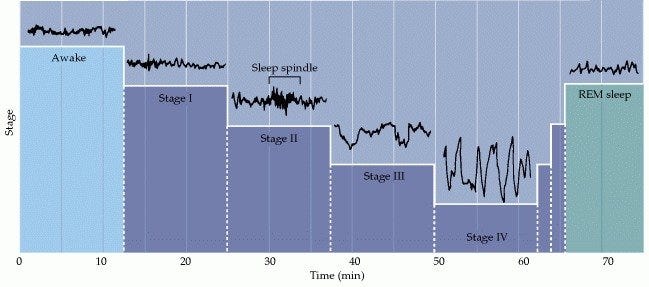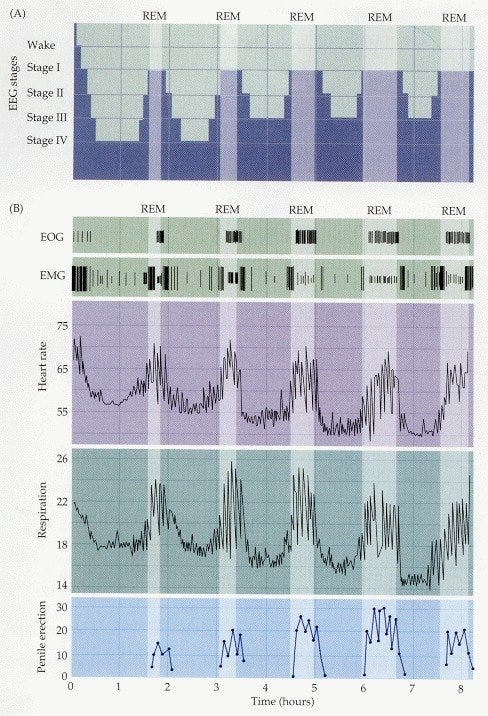Get Started with Dreamwork by Delving into the Science of Dreams
Written on
Chapter 1: The Foundation of Dreamwork
To engage effectively in dreamwork and observe your dreams, understanding sleep is crucial. Sleep is vital for human existence, ranking just behind water in terms of necessity for life. The record for the longest time spent awake is 264 hours—approximately 11 days—whereas people can survive without food for over a month. While the exact reasons for sleep remain elusive, numerous well-researched theories exist, supported by a wealth of peer-reviewed studies. The fields of sleep and dream science are still evolving, so let's examine what we currently know.
Circadian Rhythm and Its Role
The evolution of sleep patterns in humans, and many other animals, is closely tied to the circadian rhythm. This rhythm helps the body track a 24-hour cycle, which aligns with the natural day-night cycle and the amount of light we receive. A part of the hypothalamus called the suprachiasmatic nucleus (SCN) plays a pivotal role in this process, continuously monitoring various bodily functions to gauge time.
The SCN observes factors such as digestion (including meal timing), muscle activity (notably decreasing before sleep), and light exposure, which is its primary means of determining whether it's day or night.

Chemical Signals and Sleep Induction
In harmony with the SCN, the brain generates a chemical known as adenosine. Throughout the day, as you remain awake, adenosine accumulates, signaling that it’s time for rest once a certain threshold is reached. This chemical, along with the circadian rhythm, helps indicate when sleep is necessary.
When it's time to sleep and the adenosine levels are sufficient, the brain initiates the production of melatonin from the pineal gland. This hormone signals that it's time to wind down and encourages you to prepare for bed. It's important to clarify that melatonin is often mischaracterized as a sleep aid; rather, it facilitates sleep onset without directly influencing sleep quality.
Once melatonin is in your system and you decide to head to bed, you are ready to navigate through five distinct sleep stages.

Understanding the 5 Stages of Sleep
Research indicates that sleep consists of five stages, cycling through them throughout the night. The first two stages are categorized as light sleep, which accounts for about 45-55% of total sleep time. Light sleep is marked by reduced muscle tension and slow eye movement, and an EEG would show minimal brain activity with occasional bursts known as spindles.
Stages three and four represent deep sleep, also known as non-rapid eye movement (NREM) sleep. During these stages, brain activity shifts to slow delta waves, with no eye movement or measurable muscle tension. Awakening from NREM sleep can often leave you feeling disoriented and sluggish.
Stage five is where rapid eye movement (REM) sleep occurs, and this is when most dreaming takes place, although dreaming can happen in other stages as well. Each sleep cycle lasts roughly 90 minutes, with varying amounts of time spent in each stage.

Dreaming and the Importance of REM Sleep
Though all sleep stages serve important functions, REM sleep is particularly intriguing due to its association with dreams. During REM, brainwave patterns resemble those of a person who is awake, characterized by rapid eye movements, irregular breathing, and an increased heart rate.
To distinguish REM sleep from wakefulness, the body undergoes a state known as REM atonia, where the brain releases GABA and glycine to suppress muscle activity, ensuring that you remain motionless and do not act out your dreams.
This protective mechanism is vital, as it prevents physical actions that could lead to injury while dreaming. Some individuals may experience issues with REM atonia, leading to phenomena like sleepwalking, which is more common in children but can persist into adulthood.

Strategies for Enhanced Sleep and Dreamwork
To maximize the benefits of dreamwork, it's essential to establish a conducive sleep environment. Sleep is a complex interplay of multiple factors, and by focusing on the following areas, you can improve your sleeping habits:
- Circadian Rhythm: Consistency is key. Consider maintaining regular sleep and wake times to support your body's natural rhythm.
- Chemical Processes: Be mindful of what you consume. Avoid caffeine late in the day and try to have your last meal earlier in the evening.
- Five Stages of Sleep: Ensure you're getting adequate time in each sleep stage. If you often wake up feeling drained, you may need to reassess your sleep patterns. Consider using a sleep tracker for insights.
- Managing REM Atonia: If you experience sleepwalking or talking, seeking professional help could enhance your sleep quality.
Implementing these strategies can lead to restorative sleep, which in turn enhances your ability to dream vividly and recall those dreams.
Assess your sleeping environment and habits critically, and make the necessary adjustments to prioritize sleep, as it is fundamental to well-being—second only to hydration.
Wishing you restful nights filled with insightful dreams!
Video Description: This video titled "Dreamwork: Working With Dreams" explores the fundamental aspects of engaging with dreams, offering practical tips and insights into dream analysis.
Video Description: "Integrating Dreamwork and EMDR Therapy with Dr. Andrew Dobo" discusses how dreamwork can be effectively combined with EMDR therapy for enhanced therapeutic outcomes.